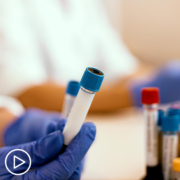Thriving with an MPN: What You Should Know About Care and Treatment
Thriving with an MPN: What You Should Know About Care and Treatment from Patient Empowerment Network on Vimeo.
MPN specialist and researcher, Dr. Abdulraheem Yacoub, reviews factors that help guide care decisions for MPNs – essential thrombocythemia (ET), polycythemia vera (PV), and myelofibrosis (MF). Dr. Yaboub discusses the goals of treatment, shares tools for taking an active role in your care, and provides an update on promising new therapies for MPNs.
Related Programs:

|

Updates from ASH: How Biomarker Testing Has Changed MPN Care |

|
Transcript:
Katherine:
Hello, and welcome. I’m Katherine Banwell, your host for today. Today’s program is about how to live and thrive with an MPN. We’re going to discuss MPN treatment goals, and how you can play an active role in your care.
Before we get into the discussion, please remember that this program is not a substitute for seeking medical advice. Please refer to your healthcare team about what might be best for you.
All right, let’s meet our guest. Joining me today is Dr. Abdulraheem Yacoub. Welcome, Dr. Yacoub. Would you please introduce yourself?
Dr. Yacoub:
Hello, Katherine. And thank you very much for inviting me to participate in this very important and near and dear topic to my heart and to everything I do every day.
I’m a hematologist-oncologist at the University of Kansas. I practice hematology 100 percent of my time, and I dedicate it to patients with MPNs. I’m an active researcher through clinical trials at my own institution, as well as part of many national and international collaborations. We all strive to provide the best care and the updates for our patients. I’m also a Director of our hematology clinics in cancers at the University of Kansas, and I’m an Associate Professor of Medicine at the University of Kansas.
Katherine:
Well, thank you so much for taking time out of your very busy schedule to join us today. We appreciate it.
Dr. Yacoub:
Absolutely, my pleasure.
Katherine:
To give our patient audience some context before we get into the specifics of MPN treatment approaches, how would you define treatment goals?
Dr. Yacoub:
Thank you, thank you. And I always like to highlight and emphasize that unlike many of the cancer syndromes that patients deal with, myeloproliferative neoplasms are unique.
These are chronic cancers. There’s no finish line. And this is a disease you live with. It affects every day of your life, every activity of your future life. You plan your life events accordingly. Pregnancies and marriages and trips and all of that. So, this is a chronic cancer. And as we plan therapy, we always factor that in. We would like the cancer to have the least or almost no impact on your daily life.
Whether it’s symptoms, whether it’s disability and dysfunction and inability to perform your daily functions, whether it’s actual physical symptoms that you’re having from the cancer, or whether it’s affecting complications that are hurting your health. So, we would like to focus on all of these, the medical aspect as well as the impact of the disease to everyday symptoms.
This is a unique feature of these cancers. And it doesn’t really exist much in other diseases.
Katherine:
That’s helpful to understand as we move through today’s program. And we’re going to cover the three classic MPNs, polycythemia vera, essential thrombocythemia, and myelofibrosis.
So, for the person who has one of these conditions, can you help us understand the treatment approaches for each? Let’s start with essential thrombocythemia or ET.
Dr. Yacoub:
Excellent. So, I’m going to start with some general concepts. So, as we approach our patients, we would like to get a good assessment of the disease burden to their lives. These can be symptoms. So, we actually have very good objective tools to measure symptoms, such as the MPN-SAF. It’s an objective tool to calculate the symptoms. So, we would like to get an objective baseline of symptoms.
Because we do want to address the symptoms, regardless of the MPN subtype. We do want to master actually the symptoms because that is what patients feel every day and we want to affect that early in the treatment. We also would like to get a good assessment of the disease complications. Have the patient suffered a clot or a hemorrhage or symptoms because of an enlarged spleen? Or were they unable to perform certain activities? Are they able to eat? Are they losing weight?
So, we would like to see how is the cancer also causing them immediate morbidity, and we also would like to tackle the future. So, cancers tend to get worse with time. They tend to transform into a higher risk cancer. So, as we approach any of the MPN patients, we also talk about the future risk of the cancer turning into a more aggressive form of cancer.
So, we would like if we can, for every patient to focus on these three pillars of their care: their immediate quality of life and symptoms, their immediate complications, and their future disease progression.
And we would like to factor in that our treatments does not add more side effects to their lives. So, that’s the fourth pillar of how we take care of patients. So, these are the basic concepts that will apply today for all patients with all three diseases.
Some patients will have more emphasis on one or the other. But this is something in our mind as doctors who treat MPN patients, we try to balance all these three pillars for every patient. So, let’s talk about essential thrombocythemia. This is among the other MPNs, the cancer with the lowest risk. Patients with essential thrombocythemia can have clots and can have bleedings. And they also often have symptoms because of their cancer.
But they also enjoy a long life expectancy that is almost indifferent from patients who don’t have cancer provided they get good care. So, our emphasis is on focusing that their life quality is not touched by their cancer, and focusing on treating patients with symptoms, to ameliorate the symptoms and allowing them to have a decent and good quality of life. At the same time, we would like to reduce the risk of clotting and bleeding.
And we have tools and medicines that are very effective at doing that in select patients who we define as high risk. And now there is a more clear definition of that. So, high-risk patients are patients who are over age 60 and have a JAK2 mutation, or patients who have already had a clot.
That is not the majority of ET patients actually. The majority are not high risk. And those patients might not require therapy to reduce their platelet count.
But for high-risk patients, we have tools to help them. So, hydroxyurea (Hydrea) is the most commonly used medicine in this setting.
The goal of hydroxyurea is to reduce the platelet count. And we’d like to keep it under 400, sometimes under 600 under different circumstances. And that will reduce the risk of clotting and bleeding for our patients. The other option, which I also feel passionate about is interferon.
Interferons are drugs that we’ve used for decades. They’re very effective. They’re safe in the right hands.
And they do have advantages over hydroxyurea in terms of long-term safety. These are medications we can give to young patients, we can give to pregnant patients, we can give for long term without concerns of toxicity, and also they have a higher ceiling. Patients with interferon can achieve a disease control that we cannot achieve with hydroxyurea.
And this will be beneficial long term treating those patients. So, these – Yeah, and then aspirin therapy is always something we would like to include in this regimen.
Katherine:
I was going to ask you about that. So, aspirin is still being used as a treatment?
Dr. Yacoub:
Absolutely. So, the standard of care is to use aspirin. Usually, one baby aspirin once a day, preferably in the morning is what we recommend. And that’s probably all the aspirin they need. We do not want them to take more than that either.
Katherine:
And you mentioned using interferons for ET. That’s something that you would also use for polycythemia vera. Yes?
Dr. Yacoub:
Absolutely. So, the same principles will apply to polycythemia vera. We would like to treat the higher-risk patients more aggressively. Hydroxyurea and interferon are also the first-line therapies in these patients.
The good news in 2022 is that we actually finally have an FDA-approved interferon for our patients. Finally, after 50 years of using interferon, now, we have an FDA approval. So, the new interferon, ropeginterferon alfa-2b is a medication that was studied prospectively in Europe, and it has been approved and in clinical use in Europe under the brand name Besremi.
And this year, it was approved in the US for patients with polycythemia vera, which is a great achievement for the medical field and a great tool to help our patients. We have used other brands off-label in the past, but it’s glad now to get this confirmation from the FDA that this is a standard of care for all patients.
And then beyond that, ruxolitinib or Jakafi, is also approved as a second-line option in patients who have had hydroxyurea as their first line.
So, these are the medicines we use for polycythemia vera. We also use therapeutic phlebotomy. And the goal in high-risk polycythemia vera, or actually in all patient polycythemia vera, is to reduce their hematocrit.
And we want it under 45 percent every day of the year. And we use the tools that we just discussed phlebotomy and medicines to achieve that, in addition to aspirin. So, that’s how PV is more unique than ET. Yes.
Katherine:
And since myelofibrosis is a progressive condition, I imagine it’s more difficult to manage. So, what else is available for patients with myelofibrosis?
Dr. Yacoub:
Correct So, myelofibrosis is the higher end of this spectrum of cancers.
It is a cancer that is associated with much higher symptom burden and impact on daily life. It is also associated with low blood counts, and some patients will require transfusions. It’s a major morbidity to our patients. And in addition, it’s a cancer that is associated with shortened life. So, patients with myelofibrosis will not live as long as their health would have allowed them. And some of them will live actually a much shorter life than they want or deserve.
So, myelofibrosis treatment requires a lot more considerations. So, for patients who are in good health, who have a cancer that is more aggressive, that would be imminently impacting their longevity, we start a discussion about a curative role of allogeneic stem cell transplantation very early in their course.
Because bone marrow transplantation can be curative, and those patients can live a long life after a successful transplant. So, this is a treatment modality that should be brought up very early for patients with higher risk myelofibrosis. There are approved JAK inhibitors, ruxolitinib and fedratinib (Inrebic). And we know that Ruxolitinib which has been approved for over 10 years can improve symptoms, can improve the spleen volume, can actually prolong lives for patients on it, and also makes the transplant more successful.
So, we should be offering that to the appropriate patients also early in their diagnosis, in a strategy where, in addition to that, we get them to a transplant. Fedratinib is approved in that setting. And we are very optimistic that by the end of this calendar year, we will have two other JAK inhibitors approved.
So, we look forward to those two drugs. Momelotinib and pacritinib for patients with special disease features.
[Editor’s Note: As of February 28, 2022, pacritinib (Vonjo) has been approved for the treatment of myelofibrosis patients with severe thrombocytopenia.]
And hopefully, by the end of this year, we will have a list of JAK inhibitors that we can choose from, which is great news for our patients.
Katherine:
Oh, we’re still fighting.
Dr. Yacoub:
Yes, absolutely.
Katherine:
As with most conditions, all patients are different, of course, and what might work for one person might not be appropriate for another. So, how do you choose which treatment is right for a patient?
Dr, Yacoub:
Excellent. So, and that’s actually the heart of what we define as the art of practicing medicine and being patient-centric and focused. And patients already have their own wishes and their needs. And everything should start with having a discussion with patients on what is their priority, and what are they trying to achieve.
And we do have to explain to them the tools we have, the interventions that can help them. But we also need to make sure they’re compatible with what they actually want and their goals in life. And sometimes what we doctors want is not exactly what the patients want. So, we always have to remind ourselves that patients are the drivers of their care. And they have the absolute right to be informed and to make informed decisions based on the options we advise them about.
So, that is always a centerpiece of healthcare. And then patients – Basically, we defined four pillars of care. We want to control their symptoms, we want to prevent complications, we want to modify the disease so it doesn’t transform, and we want our therapies not to have toxicities, not to have side effects that are worse than the disease. So, we bring that up to the table. And we also look at the patient. What is their symptoms? What did the disease cause them to be complications?
What is the risk that their cancer is actually going to progress quickly to hurt their lives? And how serious is the therapy we’re recommending? And we need to make sure that there is a good match between what we’re offering and what the disease is manifesting. So, for example, for patients who have a lot of symptoms, but they have low-risk cancer that they can live with for a long time, we focus on symptoms. We focus on treatments that improve their symptoms.
While with patients who have more serious diseases that are eminently life-threatening, we focus on an expedited path to a more aggressive therapy and a bone marrow transplant. And then we also try to match those therapies with the other patient’s wishes and needs and so forth. So, all these factors are important. We have more tools to try to prognosticate. So, prognosticate is the medical word that we use as forecasting.
We like to forecast the disease or the cancer. We try to predict the patient’s future. Fortunately, we actually have good tools to prognosticate now. We have models or calculators that factor in patients’ features, their symptoms, their age, their blood counts, their bone marrow findings, and their DNA mutations. And it gives us a score a risk score that can correlate with their life expectancy or their outcomes.
And we use those tools to guide us. So, there’s actually a tool we use to help patients reach that decision. It’s an objective tool to decide how serious is this disease and how seriously we should tackle it. It’s very applicable for patients with myelofibrosis, more sort of the other lower-risk cancers.
Katherine:
What about comorbidities? How do they fit into the treatment plan?
Dr. Yacoub:
Very important.
So, again, it also goes back to finding the balance between how serious is the disease, how serious is the treatment, and how will the patient’s general health tolerate and factor in the choices patients make accordingly. So, myeloproliferative neoplasms do happen in a broad range of ages. And we have children, minors with MPNs, and we have elderly patients with MPNs. And it’s a continuous spectrum. And each individual patient will have their own health concerns and their own health comorbidities and their own wishes. And we always have to make sure that we match our therapies, the disease seriousness, and the patient’s wishes, which is also stemming from their own other health battles, too.
We cannot turn a blind eye to the other health issues going on. That plays a major factor as we choose to discuss bone marrow transplantation with patients. Because that’s when the medical comorbidities are often the first barrier to go through.
Katherine:
Are there specific biomarkers that may affect prognosis or treatment?
Dr. Yacoub:
Yes. So, and we’re glad that actually myeloproliferative neoplasms are actually the model in medical oncology on how predictors can tell us a lot more about the patient’s future about the prognosis. So, early on in MPNs, we’ve developed models, like the International Prognostic Scoring Systems in many different iterations. And more recently, the Molecular Based International Prognostic Scores.
They factor in patient’s age, they factor in blood numbers, they factor in DNA abnormalities, they also factor in DNA mutations, including the common driver mutations JAK2 and CALR and MPL, as well as more novel mutations that we call higher risk mutations.
So, based on these models, we use these tools to predict how the cancer will behave, and how to approach it. This advancement has been an application for our MPN patients for a while, way ahead of all other fields of oncology. So, we’re proud that we can give our patients this tool before all other doctors were able to. Yeah.
Katherine:
That’s excellent. Dr. Yacoub, what is the role of the patient in their care? When does shared decision-making come into play?
Dr. Yacoub:
Absolutely.
Patients are the drivers and the centerpiece of their health care. And patient self-advocacy is the most important tool. So, many of our patients are young and they will live with their cancers a lot longer than many cancer doctors will practice oncology. And they will have many doctors. Statistically, each MPN patient will have multiple doctors throughout their career. And they will hear different derivatives. And the science will change. And they will be given different counseling over the time. And their disease will change.
And they will have different needs as they go further. So, patients being involved in their wellbeing and their cancer care is important from the first day. And I always tell patients, “You need to start building your village from day one.” It is not just the patient, it’s your caregivers, it’s who else can help you.
Who else can advise you? You might want to also invest in a friend or a spouse or a child, to come to you and listen to some of those discussions so that they can advise you later on, “Why are you making different decisions?” So, we encourage patients to be very involved early on, to build their own village, and to seek care. We routinely ask for second opinions. We want patients to always hear the story and hear the same story from another doctor so that they hear the range of how we word the truth and how we word the facts.
And this way, they can have a better perspective. So, this is now a standard. Almost all patients should have two doctors, at least, the treating doctor and one doctor who’s an MPN specialist, who would give them another twist or another perspective to their health.
So, and that is always important. And then there are very good references and online resources for patients to tackle in, such as this seminar and other good places where patients can seek more information. They also can go to a clinical trial to find out what are the ongoing clinical trials and advancements.
There are structured patient symposiums nationally and regionally. So, and we strongly recommend that patients seek more opinions and more help and more resources and be very engaged with this disease, especially that it is a chronic cancer, and it’s not going to –
Katherine:
It’s not going away.
Dr. Yacoub:
It’s just a new lifestyle. And they need to be as engaged with it as they can.
Katherine:
Absolutely. We have a couple of questions from the audience. This one is from Sarah. She writes, “I’ve been living with essential thrombocythemia for three years, and have been relatively stable. Of course, I’m worried about progression to PV or MF. What is my chance of progression, and what are the signs of progression?”
Dr. Yacoub:
That’s a very good question. And unfortunately, we’re very good at describing those numbers. Unfortunately, our tools at interfering are not as good. So, in general, patients with ET, statistically speaking, have a life expectancy that is not different from their age match peers. And Sarah’s story will be not too indifferent from her sisters and her mother, in terms of what’s going to happen to her long care and her health, provided she gets good medical care. The exception to that is that there is a transformation risk. For ET we caught around a 4 percent every 10 years in which ET will actually change into a different cancer, a higher risk cancer.
Could be MF, could be MDS, could be acute leukemia. And that will be a much more serious diagnosis. So, it’s about 4 percent in 10 years. We do have a – or we extrapolate some of the data from other cancers. So, certain mutations are more favorable, certain mutations are more risky. And we try to forecast that but worried it’s really hard to predict that since it’s such a long journey with disease. The first symptoms or the findings, when patients start suspecting that their disease has changed, is that the pattern of symptoms that they have are different.
They often become worse. So, they have more constitutional symptoms, more tiredness, more fevers, more night sweats, losing weight, not being able to eat a full meal, abdominal distension, the spleen gets bigger.
So, these are some of the feelings that patients can experience that lead to this. Other objective things is when the blood tests change in a less favorable way. So, for patients with ET who always run at 800,000 platelet count, if they’re suddenly 200, and that’s in the normal range, but that’s actually not good news, because the cancer changed. And this change is not favorable. So, as the doctors run routine labs, if they see the sudden change in labs, that’s also abnormal.
If the doctor can feel that the spleen gets bigger every time, that’s also concerning. If the patients suddenly have anemia or very high white cell count or immature white cells in the blood, that’s also a concern.
So, that’s why it’s great or important to establish a baseline symptom burden.
A baseline spleen, a baseline bone marrow biopsy with mutation analysis, so that patients have a clear reference point to where they started, and if things change, they can always go back to that point and compare.
Katherine:
Right. We have another question. This one from Victor. He says, “I was diagnosed with PV in 2018. And I’ve been treated with hydroxyurea. Recently, I’ve been very fatigued. I want to exercise, but I don’t have the energy to do much. Do you have any advice for boosting my energy?”
Dr. Yacoub:
That is a very good question and very common question. So, the causes for fatigue in adults, in general, so many. And adding PV to that adds a few other reasons why one would be more fatigued. So, assuming that Victor follows with his doctor, and his primary care doctor has systematically went through all the possible causes for fatigue, and those were addressed.
Now that PV specific causes, A). Hydroxyurea can cause fatigue. So, maybe it’s the hydroxyurea dose. And that’s a side effect. And maybe that’s not the best medicine for him. B). Polycythemia vera can cause fatigue. Maybe we’re not controlling it enough. Maybe we need to dial up the dose of the medicine or dial down the dose of the medicine accordingly. And then there’s also the iron deficiency which we induce with PV and phlebotomy.
And whether we actually have taken Victor to become very low on iron, and that can cause fatigue. So, we have to evaluate the treatments, the disease, and the side effects of the interventions we’ve done. And those are the polycythemia vera specific factors that can add to the fatigue.
Katherine:
Here’s another question from the audience. This is from Sandy. She writes, are MPNs hereditary? Should my children or siblings be aware of their risk?
Dr. Yacoub:
All right. Well, the answer to that question changed many times over the last 10 years. So, the answer changed from absolutely not, to very possibly maybe over the years. So, although we don’t think of cancers as inherited, it’s not passed from one parent to their children. But MPNs tend to run in families. And for 11 percent of patients with MPN, and that number has also increased over the years, have actually a first-degree family member with MPN. That is a big coincidence, it’s almost too high to be a coincidence. So, we are realizing that there is genetic makeup or clustering that can cause MPNs to happen more often in certain families.
So, how does this apply to patients? So, if a patient has MPN, that does not mean that their children or siblings will get MPN, it just means they’re more likely than the other people to have MPN, just because they all share the same genetic makeup. And they should be made aware. And they should maintain good health care and maintain the relationship with a primary and have routine labs and all that. But not necessarily that they will get cancer. This still is a very rare disease, and 11 percent of a rare disease still is a small number.
Katherine:
Thank you for answering those patient questions. I appreciate it.
Dr. Yacoub:
My Pleasure.
Katherine:
And to our patients, please continue to send in your questions to question@powerfulpatients.org and we’ll work to get them on future programs.
So, Dr. Yacoub, as we close out our program and our conversation, I wanted to get your take on the future of MPN research and treatment. Are there new developments that you’re excited about and that make you hopeful?
Dr. Yacoub:
Absolutely. So, again, I would like to take the last few minutes to advocate for the future. And the future can only come when doctors and patients and advocates work together to advance the science. We have few tools to treat patients and to help patients. We have a lot of unanswered questions. And the only way to answer them is by designing quality clinical trials, enrolling patients on trials, taking the risk, and trying to find new answers and new therapeutics. So, I always would like to advocate for patients to seek clinical trials whether with their doctor or whether they have to travel for it, and for doctors to consider that for their patients. That’s the only way to advance science.
There are very important national and international studies going on right now. One of the – And first, I would like to emphasize is that we have had ruxolitinib as the only therapy, or the first-line therapy for myelofibrosis for a decade now. Not everybody responds to it, not everybody responds to it for a long time. So, now we’re designing combination trials. So, there’s a few studies that are trying to redefine, “Is ruxolitinib alone enough, or should we have a combination first-line therapy?” So, these are some of the more important questions being asked right now.
And this is definitely one of the bigger moves in the field, is trying to redefine what is the first-line therapy for myelofibrosis. For polycythemia vera, we’re also exploring therapeutics that would reduce phlebotomy with things you can add to your medical care to reduce phlebotomy.
So, that’s also going on. And it’s definitely a big leap forward for many of our patients. For ET, when we don’t have any actual drugs approved other than hydroxyurea and anagrelide (Agrylin), we actually have trials with interferon going on.
So, I would like to advocate for that. So, interferon succeeded and now approved for PV, but not yet for ET. We’re working on that. So, again, in every disease, we’re trying to design clinical trials to redefine what is the best treatment today.
We’re also doing studies to understand the cancer. So, studies where patients donate their samples for research. These are very helpful, very important. And contributing to that always advances the science, and it’s low effort to the patients. So, if there’s a clinical trial that is offered to patients, I would strongly urge everybody to consider that favorably and contribute to science.
That’s the only way we can help future patients and ourselves immediately, at moving the field forward.
Katherine:
Seems like there’s a lot of progress in the field.
Dr. Yacoub:
A lot of progress. I look forward to future events. I’m going to have a lot more tools to discuss. Hopefully, by this time next year, we’re going to have four JAK inhibitors, injectables for PV, interferon for ET, and a lot more things to go over.
Katherine:
That’s wonderful. Dr. Yacoub, thank you so much for taking the time to join us today.
Dr. Yacoub:
You’re welcome. And it’s my pleasure. I feel passionate about this. And I’m happy to help.
Katherine:
Thank you. And thank you to all of our partners. To learn more about MPNs and to access tools to help you become a productive patient, visit powerfulpatients.org. I’m Katherine Banwell. Thanks for being with us today.

















